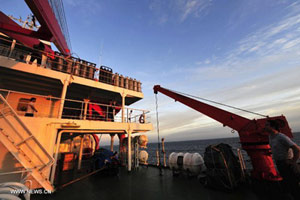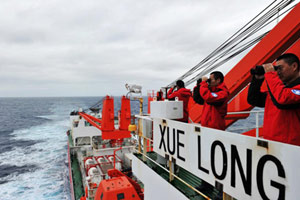Australia vows to keep searching for plane
(Xinhua) Updated: 2014-03-23 20:40CANBERRA -- Australian Deputy Prime Minister Warren Truss and senior maritime rescue officials reiterated on Sunday that they will keep searching the southern Indian Ocean for missing Malaysia Airlines flight MH307 for as long as they have hope.
"We're hopeful obviously for breakthroughs but these kinds of searches can take a very long time especially when they're in remote locations as is the case in this instance," Truss said in a televised press conference at the Australian Maritime Safety Authority (AMSA) in Canberra.
"We hope that soon there'll be more information available that might help to provide some kind of closure or at least an understanding of what's happened, especially to the families of those who were on board Malaysia Airlines flight 370," said Truss.
"The search will continue and will continue as long as there's hope, and I hope that we'll find a time soon when we're able to conclusively say once and for all that we are close to finding where this plane may now be located."
AMSA general manager of emergency response John Young said searchers were on Sunday hoping to find again the objects spotted by airborne observers the day before so they could be recovered and to find the objects identified in American and Chinese satellite photos.
"Today is really a visual search again and visual searches take some time. They can be difficult," Young said at the press conference.
Two Chinese Ilyushin 76 aircraft had been preparing for the operation on Sunday and would take part on Monday, while Chinese warships were expected to arrive in the area on Tuesday, said Young.
"China clearly has an intense interest in this search operation. I believe they had 154 people on board the aircraft," he said.
AMSA Rescue Coordination Center chief Mike Barton said four civil and four military aircraft were taking part in Sunday's search.
AMSA personnel were coordinating information gained from self- locating datum buoys with expert opinions from home and abroad to identify search areas, he told the press conference.
"We put all of that information together and any new intelligence that comes to us about satellites to formulate an area and we'll redo it again tonight based on what observations might have occurred in today's flying and look to go out searching again and then we'll do it again and again until we have some sort of closure or positive sightings in the area," said Barton.
Observers on Saturday identified a wooden pallet, some strapping belts of different colors and "other nondescript items," he said.
The use of wooden pallets was quite common in the airline industry, he said.
"The challenge of this search hinges around its remoteness from anywhere," said Barton.
"The aircraft are operating at extreme ranges from Perth, which is the closest air field, or RAAF Base Pearce, which is up the road, and so at 2,500 km away they're operating at the limits of their endurance and only having a short period of one to two hours in the search area, and then back again," he said.
"That's only allowing us to get in a singular search a day which is again spreading the search out over several days."
 |
 |
|
Live report: Malaysia gets new satellite images of potential debris |

|
 |
Video: Friend defends MH370 pilot Nik Huzlan, a previous classmate of Captain Zaharie, speaks high of the pilot. |
 |
Video: Officials remain puzzled Tension mounted as the search for the missing Malaysian airplane continued. |
- Xuelong to arrive at search area Tuesday
- Ocean hunt for missing jet focuses on pallet
- More planes join ocean hunt for missing jetliner
- Search for missing jet focuses on Chinese satellite photos
- No evidence of missing jet flying over Indian airspace
- Chinese aircraft offers hope to search for missing jet




